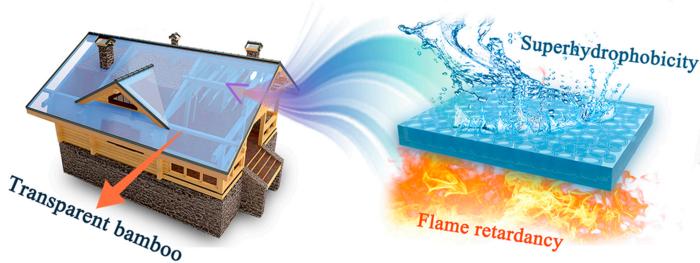Professors Yiqiang Wu and Caichao Wan, along with their team from Central South University of Forestry and Technology (CSUFT), have pioneered a groundbreaking transparent material derived from natural bamboo. This innovative material features a three-layered flame-retardant barrier, effectively reducing heat release, slowing flame spread, and restraining the emission of combustible volatiles, toxic smoke, and CO. Their findings have been documented in the journal Research.

Credit: Research
Professors Yiqiang Wu and Caichao Wan, along with their team from Central South University of Forestry and Technology (CSUFT), have pioneered a groundbreaking transparent material derived from natural bamboo. This innovative material features a three-layered flame-retardant barrier, effectively reducing heat release, slowing flame spread, and restraining the emission of combustible volatiles, toxic smoke, and CO. Their findings have been documented in the journal Research.
Silica glass, a widely used transparent material in the construction industry, has seen increased adoption as an essential building material over the past 50 years. Its versatility is reflected in the global glass production reaching approximately 130 million tons in 2020. According to C. Wan, a full professor at the College of Materials Science and Engineering at CSUFT and a corresponding author of the paper, “Despite its numerous advantages such as high transparency and the availability of raw materials, traditional silica glass still grapples with challenges including brittleness, high density, and substantial CO2 emissions and greenhouse gases during the manufacturing process.”
In recent years, there has been a surge of interest in transparent wood products, thanks to their remarkable features like high transparency, excellent mechanical strength, and superior thermal insulation properties. Transparent wood not only offers environmental benefits but also holds huge potential as a viable alternative to traditional glass materials. Nevertheless, there are several limitations associated with the utilization of transparent wood: (a) global wood scarcity, particularly in China, poses a challenge; despite efforts to increase production through plantations, it is projected that the demand for industrial
roundwood in 2050 will exceed supply; (b) the use of polymers in transparent wood makes it highly susceptible to fire, posing a potential hazard; and (c) there is a need to further enhance the functional properties of transparent wood beyond its basic optical and mechanical attributes.
“Bamboo, often referred to as ‘the second forest’, boasts a fast growth and regeneration rate, allowing it to reach maturity and be utilized as a building material within 4 to 7 years of growth,” says Wan, “with an output 4 times higher than wood per acre, bamboo is recognized for its exceptional efficiency.”
“In terms of chemical composition, bamboo shares similarities with wood, mainly consisting of lignin, cellulose, and hemicellulose. Furthermore, the internal hierarchical structure of bamboo closely resembles that of wood, featuring high porosity and permeability because of neatly arranged vertical channels. This characteristic suggests the potential use of bamboo in the production of transparent composite materials.” says Y. Yang, PhD student in Wan’s lab and lead study author.
The team’ solution is to impregnate an inorganic liquid sodium silicate (Na2O·nSiO2) into the delignified bamboo structure using a facile and efficient vacuum-impregnation technique. Subsequently, a hydrophobic treatment is applied to the intermediate product. “Through this strategy, we can build a 3-layered flame-retardant barrier comprising a top silane layer, an intermediate layer of SiO2 formed through hydrolysis–condensation of Na2SiO3 on the surface, and an inner layer of Na2SiO3)” Wan describes. “This strategy achieves a long ignition time of 116 s, low total heat release of 0.7 MJ/m2, low total smoke production of 0.063 m2, and low peak CO concentration of 0.008 kg/kg.” The bending and tensile moduli of the transparent bamboo are as high as 7.6 ± 1.3 and 6.7 ± 1.1 GPa, respectively, demonstrating its excellent mechanical properties.
In addition, when used as a substrate for perovskite solar cells, the transparent bamboo shows the potential to act as a light management layer due to its high light transmittance of 71.6% and an impressive fog value of 96.7%, leading to a marked enhancement of 15.29% in power conversion efficiency.
They are excited that this discovery opens the door for green flame-retardant glass and optical device applications. “In the future research, we will focus on the large-scale fabrication and multi-functionalization of this transparent bamboo,” adds Wan.
Journal
Research
Method of Research
Experimental study
Subject of Research
Lab-produced tissue samples
Article Title
A Novel Flame-Retardant, Smoke-Suppressing, and Superhydrophobic Transparent Bamboo
Article Publication Date
14-Apr-2024
COI Statement
C.W. and Y.W. conceived the concept and supervised the work. J.S., Y.Y., and C.W. designed and conducted most of the experiments and drew the schematics and graphs. Y.Y. and C.W. helped with preparation of raw materials. C.W., Y.C., H.C., and J.Y. contributed to the application demonstrations. J.S., Y.Y. and C.W. analyzed the data and cowrote the manuscript. C.W., X.L., Y.C., and Y.W. revised the paper. All authors commented on the submitted version of the manuscript.



